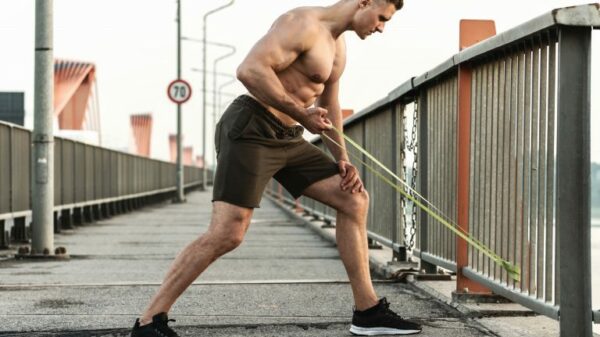Back exercises not only sculpt that awesome V-shape. They’re the best way to combat back pain and injuries. Your back is a complex set of ligaments, bone and muscle. The whole thing is held together and set in motion by 224 ligaments and 143 back muscles. We’ve developed training routines to cover the whole range of levels whether you’re a beginner or seasoned gym rat. Well show you here how best to train these 143 power packs at home.
Which muscles make a strong back?
The muscles around the spine can be roughly divided into three layers
1. The top layer is directly under the skin which makes the muscles easier to target in your training routines. The dominant muscles of the top layer are the like erector spinae, latissimus dorsi and teres major.
2. The middle layer includes individual muscle bundles that fan-shape from vertebral body to vertebral body. These include the serratus muscle and the rhomboid muscle.
3. The lower layer consists of short and strong muscles that pull straight, obliquely or diagonally. These include the multifidus, quadratus lumborum and semispinalis thoracis. They constantly balance your body without you noticing anything. For a strong and healthy back, its important to train all three shifts. Please note that the abdominal muscles are also important because they take on the support function in many everyday movements. That is why abdominal exercises should be part of any sensible back workout.
THE TRAINING PRINCIPLES
How to begin building powerful back muscles at home
The best workout to start with is a full body workout, which not only strengthens your back muscles but your stomach, legs, shoulders and arms. The entire area around the spine benefits from a combination of muscle building, balance and coordination training. A wide variety of equipment and aids can be used for back training at home.
Build the base for around 6 weeks
As a beginner, we advise you build up the back muscles and abdominal muscles with relatively simple exercises for about 6 weeks. This will build a great launching pad. Beginners ideally start with 2-3 training units a week on non-consecutive days. 30-40 minutes are enough. It is best to do 3 sets of 12-15 reps per exercise with a 60 second break in between. If you exercise alone, watch yourself in a mirror to check you’re maintaining a good posture and shape. If you are training with a partner, you can correct each other.
THE TOOLS
What equipment do I use to strengthen my back
There’s a wide range of excellent fitness equipment you can use in your workouts. Dumbbells and fitness bands are best for beginners because you can train entire muscle chains in a natural sequence of movements. Once you’ve built a solid foundation after 6-8 weeks, you can add kettlebells, balance trainers and sandbags to your repertoire. As a rule of thumb, the more varied the routine, the more effective it is.
THE BACK TRAINING
The golden rules for back training
As we’ve already covered, you shouldn’t focus exclusively on back training. Ultimately, every part of your body works together in one way or another so full body training is important. For back training itself, you should follow a few rules:
- Beginners should start with 6 exercises per training session.
- 3 of these should be for the back as well as the core and abdominal muscles.
- Choose resistances and weight you can execute the exercise technically clean and concentrated, right up to the last rep
- Keep breathing evenly throughout the exercises. If youre struggling, reduce the weight or the number of repetitions
BACK TRAINING FOR BEGINNERS
The 6 best back and ab exercises for beginners?
Here are 4 back exercises and 2 ab exercises that are ideal for beginners. Choose 3 of them and integrate them into your training. After each back exercise, choose an exercise that targets another muscle group, then pump out another back or ab exercise. Remember, its always ideal to work out in front of a mirror so you can check your executing correctly.
1 Row bent forward with dumbbells
Targets the large back muscles, large round muscles, biceps, and glutes
Depending on your fitness level, grab a 2-5kg dumbbell in each hand. With your feet shoulder width apart, bend your knees and your upper body straight forward. With your arms outstretched sideways from your body, pull the dumbbells up until they just touch your upper body. Hold briefly and then lower it again.
3 x 12-15 reps with a 60 second break.
Tip: You can also do the same exercise with a barbell. Since this makes it easier
2 Lat pull with dumbbells
Targets the large back muscles, hood muscle, delts, lats and glutes
With a 1-3kg dumbbell in each hand with an overhand grip, crouch down slightly, tilting your upper body forward with your back straight. Your arms should hang by your sides. From this position pulls both dumbbells up above your head keeping your arms straight. Hold briefly and then lower again.
3 x 12-15 reps with a 60 second break.
3 Side bend with dumbbells
Targets the outer and inner obliques and the anterior saw muscle
Holding a 3-5kg dumbbell in your right hand, stand upright with your knees slightly bent. Then bend slowly to the right and slowly lift the dumbbell to knee level. Hold briefly and straighten up again. Make sure your pelvis remains stable and doesn’t move sideways. Then switch sides.
3 x 12 -15 reps with a 60 second break.
Tip: The exercise becomes even more effective if you hold dumbbells in both hands.
4 Rowing with the fitness band
Targets the large back muscles, large round muscles, biceps, and glutes
Stand hip-width apart with your feet in the middle of your fitness band and take the ends in your hands. Bending your knees, bring your upper body straight forward and then pull your elbows back up close to your body until your hands reach the level of your navel. Hold briefly and lower again.
3 x 12- 15 repetitions with a 60 second break.
5 Lat pulldown with fitness band
Targets the large back muscles, delts, hood muscles and back extensors
Standing hip-width apart, take the fitness band in both hands to the point where you’re building tension. Then bend your knees slightly and bend your straight upper body forward. Stretch your arms with the tensioned fitness band straight above your head. From there, bend your elbow to a right angle and guide the fitness band behind your head. The head remains in line with the back. Hold briefly and stretch again.
3 x 12-15 reps with a 60 second break.
6 Horizontal pulling with the fitness band
Targets the large back muscles, the delts and the abs
Standing hip-width apart with your legs slightly bent, hold equal length ends of the fitness band in front of your body. Your arms should be slightly bent with slight tension at chest height. Then pull the fitness band apart horizontally until the band almost touches your chest. Hold briefly and pull your arms apart again without completely releasing the tension.
3 x 12-15 reps with a 60 second break.
BACK TRAINING FOR ADVANCED USERS
How do I make my back muscles stronger at home?
If you’re a seasoned trainer and have a rock solid foundation, there are a few ways to target and really buff your back muscles. For example, you can increase the dumbbell weights or the resistance of the fitness bands. You can also use a training band, which offers different levels of resistance depending on the color. To train the important deep muscles, you should also improve your coordination and balance skills. A balance pad is super-effective because it activates deep-seated muscles that work away unnoticed ensuring you can keep your balance. Up to 30% more muscles are used in this way.
In addition to dumbbells and fitness and training bands, you can also work out with kettlebells or a sandbag. They’re both a bit more complicated to use but if you have a good muscular base, you’ll give your fitness levels a real boost. Compared to the dumbbell, the kettlebells center of gravity is shifted. For back exercises, a weight of 3-8kgs is best.
Sandbags are great for extreme variable resistance training. Because the weight in the sandbag shifts with every movement, a lot more muscles are worked than when training on equipment. That makes sandbags perfect for exercising the deep muscles that are so important for the back. Depending on your strength, workout with sandbags from 5-30kgs.
4 GOAL-CRUSHING KETTLEBELL AND SANDBAG EXERCISES
1 Swing with kettlebell
Targets the large back muscles, the back extensor muscles, the deltoid muscles, the glutes and hamstrings as well as the deep back muscles
Stand a little more than shoulder width apart with your toes pointing slightly outwards. Grab the kettlebell with both hands then pull it up a little with your arms almost straight, pick up momentum, bringing it up to shoulder height. Knees, hips and upper body are stretched during this swing and momentum should have the kettlebell swinging through your legs.
2 Single leg rowing with kettlebell
Targets the large back muscles, the back extensor muscles, the dorsal muscles, the arm and glutes as well as the deep back muscles
Standing up straight, holding a kettlebell in your right hand, bend forward like a figure skater with a straight back. At the same time, stretch one leg backwards. Keeping your balance in this position, pull the kettlebell towards your upper body and then lower it back down again.
Work each side 3 x 8-12 reps with a break of 60 seconds.
3 Good morning exercise with sand bag
Exercises the large back muscles, the back extensor, the trapezius, the glutes and thigh muscles
Grab the sandbag from below with both arms and carry it in front of your chest. Standing hip-width apart and bending your knees a little, bend your straight upper body forward and down to the horizontal. Hold briefly and then straighten up slowly.
3 Xx8-12 reps with a 60 second break.
4 Power Snatch with sandbag
Targets the large back muscles, the back extensors, the deltoid muscles, the traps, the arm, buttocks and leg muscles
Grab the sandbag in a shoulder-width grip. Standing with your feet hip-width apart, crouch with your back straight until you almost touch the floor with the sandbag. Then pull the sandbag up, bend your arms with your elbows pointing outwards. Extend your arms above your head and catch the sandbag on the back of your forearms.
3 x 8-12 reps with a 60 second break.
BACK TRAINING FOR PROFESSIONALS
Hit the balance pad for incredible back muscles
If you’re hardcore trainer looking for a challenge, try doing all the above advanced exercises on a balance pad or balance trainer.
Tip: Because this is all about keeping your balance while targeting those back muscles, its a good idea to reduce your usual weights a little to ensure youre executing well.
3 x 8-12 reps with a 60 second break.














